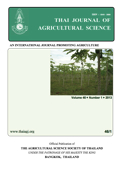Development of Ethidium Monoazide (EMA) Real-Time Polymerase Chain Reaction (EMA-qPCR) Technique for Detection and Assessment of Live ‘Candidatus Liberibacter asiaticus’ Cells in Citrus spp. Tissues
Main Article Content
Abstract
‘Candidatus Liberibacter asiaticus’ (Las) causal agent of Citrus huanglongbing (HLB) is a phloem-limited, gram-negative bacterium associated with three species of α-Proteobacterium includes; ‘Candidatus Liberibacter asiaticus’ (Las), ‘Candidatus Liberibacter americanus’ (Lam) and ‘Candidatus Liberibacter africanus’ (Laf). HLB is one of the most serious disease of citrus worldwide. Infected trees express various symptoms of blotchy mottle and yellowing, shoot stunting and slowly decline. The citrus HLB pathogen has been unculturable in artificial media. Detection of HLB bacterium is based mainly by conventional polymerase chain reaction (PCR) and quantitative real-time PCR (qPCR) with species-specific primers. However, the disadvantage of qPCR on undistinguishable between live and dead cells is a limiting factor to detect active HLB population in planta. In this study, the EMA-qPCR technique was developed to quantify live Las cells with the aid of Ethidium Monoazide (EMA) to overcome the limitation of conventional and quantitative PCR techniques. Comparison on efficacy of EMA and Propidium Monoazide (PMA) for suitable time of citrus tissues treatment indicated a longer incubation for 20 minutes by soaking the tissue either in EMA or PMA solution was better than a shorter incubation for 5 minutes. However, EMA was significantly higher detection of Las live cells than PMA due to more penetration into the tissue. Therefore, a suitable method of citrus tissue preparation by soaking, pulverizing and pulverizing with grinding in liquid nitrogen in 100 μg/mL EMA solution for 20 minutes was determined for live Las cells detection by EMA-qPCR technique. Soaking method was the most suitable among the others which was more significantly efficient, simple and convenience. A minimum live Las cells for HLB symptom expression detection by this technique in asymptomatic and symptomatic leaves found that all asymptomatic leave of Citrus spp. has low live cells than symptomatic leaves ranging from 3.38-22.09% and 24.70-37.71%, respectively which was significantly different at P < 0.05. The efficacy of EMA-qPCR technique to quantify live Las cells in mature and immature seeds was 65.56% and 12.73%, respectively which was significantly different (P < 0.05). This work evidently shown the developed EMA-qPCR technique was sensitive and useful for early detection of live Las cells in immature seed as the first significant step for producing HLB-free citrus scion and root stock. This technique was also reliable supported early detection of live Las cells for monitoring HLB epidemic in citrus grove before an effective application of HLB management measures. Additionally, this technique can be useful as a basis for development on detection of other uncultured live bacteria and phytoplasma pathogens.

